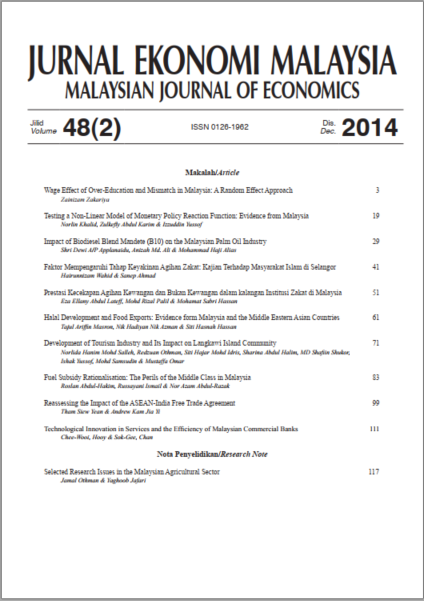Jurnal Ekonomi Malaysia
48 (2) 2014 51 – 60
Pusat Pengajian Perakaunan
Fakulti Ekonomi dan Pengurusan
Universiti Kebangsaan Malaysia
43600 UKM Bangi, Selangor D.E.
MALAYSIA
Pusat Pengajian Perakaunan
Fakulti Ekonomi dan Pengurusan
Universiti Kebangsaan Malaysia
43600 UKM Bangi, Selangor D.E.
MALAYSIA
Pusat Pengajian Perakaunan
Fakulti Ekonomi dan Pengurusan
Universiti Kebangsaan Malaysia
43600 UKM Bangi, Selangor D.E.
MALAYSIA
Abstract
Inefficient distribution of zakat institutions is among one of the causes that have affected the confidence level of the Muslim community to carry out the obligation to pay zakat to zakat institutions. The distribution inefficiencies can be seen through the surplus of zakat that are not distributed and the failure of zakat institution to distribute the zakat to eight classes of recipients and do not follow the priority of the recipients. Based on that distribution inefficiencies, the objective of the study was designed to evaluate the distribution performance of zakat institutions in Malaysia. The study has categorized distribution efficiency of zakat institutions into two, which are financial and non-financial distribution efficiency. Secondary data (zakat institutions annual report) and primary data (questionnaire) was used to obtain the data from 2005 to 2010 and being analyzed using mean analysis. The results show that, there are an improvement in financial and non-financial distribution performance of zakat institutions, although the efficiency scores obtained are not consistent. Majlis Agama Islam Negeri Sembilan (MAINS) is the zakat institution that achieved the best score for financial distribution efficiency. While Majlis Agama Islam dan Adat Istiadat Melayu Kelantan (MAIK) is the zakat institution that achieved the best score for non-financial distribution efficiency. Majlis Agama Islam Wilayah Persekutuan (MAIWP) is among the zakat institutions which has the lowest score for both distribution efficiency. The study suggest that through the distribution efficiency measurement that the formed for each of zakat institutions, institutions that the highly efficient can be used as a benchmark for others zakat institutions in order to improve the zakat institutions distribution performance in Malaysia. More relevant haddul kifayah rate should be taken seriously in ensuring fairness to the recipients and zakat institutions distribution performance.
Keywords
Bibliography
@article{abdullateff2014prestasi,
title={Prestasi Kecekapan Agihan Kewangan dan Bukan Kewangan dalam Kalangan Institusi Zakat di Malaysia},
author={Abdul Lateff, Eza Ellany and Palil, Mohd Rizal and Hassan, Mohamat Sabri},
journal={Jurnal Ekonomi Malaysia},
volume={48},
number={2},
pages={51—60},
}
Receive updates when new articles are published.


